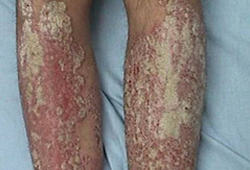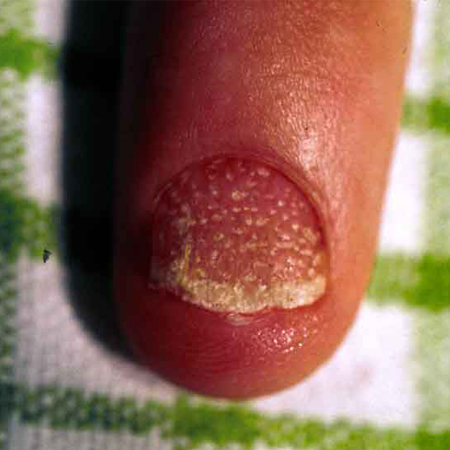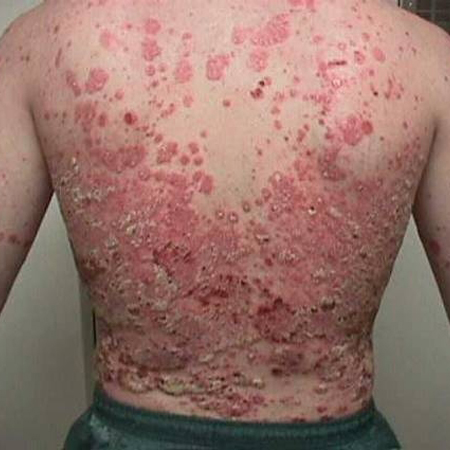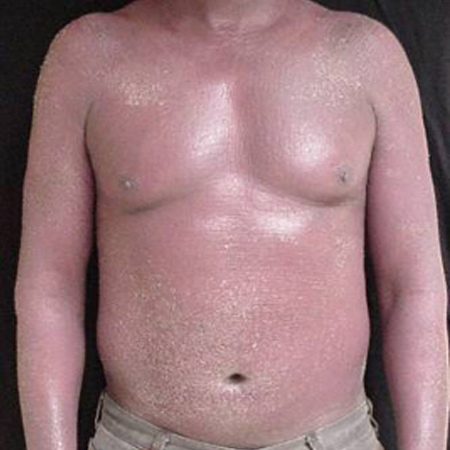Approach
Characteristic history and examination findings are often sufficient to diagnose the condition. Skin biopsy is reserved for atypical cases when lack of treatment response brings the diagnosis into question.
History
Most people with psoriasis have a positive family history.[11][16]
Psoriasis usually begins as 1 or 2 limited lesions on elbows or scalp. In the majority of cases, psoriasis remains a limited disease. However, in some people, it may spread to involve other body sites over time.
Psoriasis has a fluctuating course of flares and remission but seldom completely subsides. Patients may describe the skin as highly sensitive, and itching can be severe. Bleeding may occur if the lesions are scratched. The skin can be painful, particularly if joints are involved. It may be aggravated by environmental, emotional, or infectious factors. As part of the diagnostic work-up, determine what, if any, therapies have been used by the patient and how effective they have been. Abruptly stopping corticosteroid therapy for psoriasis or adding a known irritant medication might lead to sudden worsening.
Physical examination
The typical appearance of psoriasis is of erythematous, circumscribed, scaly papules and plaques on elbows, knees, extensor surfaces of limbs, and scalp. To help differentiate from eczema, examine the scalp, behind the ears, and the nails for pitting.[Figure caption and citation for the preceding image starts]: Plaque psoriasis on legsFrom the collection of Professor Tsu-Yi Chuang, MD, MPH, FAAD; used with permission [Citation ends]. [Figure caption and citation for the preceding image starts]: Plaque psoriasis on kneeFrom the collection of Professor Tsu-Yi Chuang, MD, MPH, FAAD; used with permission [Citation ends].
[Figure caption and citation for the preceding image starts]: Plaque psoriasis on kneeFrom the collection of Professor Tsu-Yi Chuang, MD, MPH, FAAD; used with permission [Citation ends]. [Figure caption and citation for the preceding image starts]: Plaque psoriasis on scalpFrom the collection of Professor Tsu-Yi Chuang, MD, MPH, FAAD; used with permission [Citation ends].
[Figure caption and citation for the preceding image starts]: Plaque psoriasis on scalpFrom the collection of Professor Tsu-Yi Chuang, MD, MPH, FAAD; used with permission [Citation ends]. [Figure caption and citation for the preceding image starts]: Nail psoriasis - pitted nailsFrom the collection of Professor Tsu-Yi Chuang, MD, MPH, FAAD; used with permission [Citation ends].
[Figure caption and citation for the preceding image starts]: Nail psoriasis - pitted nailsFrom the collection of Professor Tsu-Yi Chuang, MD, MPH, FAAD; used with permission [Citation ends].
Subtypes of psoriasis have a typical presentation:[2]
Plaque psoriasis
Raised inflamed plaque lesions with a superficial silvery-white scaly eruption. The scale may be scraped away to reveal inflamed and sometimes friable skin beneath.[Figure caption and citation for the preceding image starts]: Plaque psoriasis on legsFrom the collection of Professor Tsu-Yi Chuang, MD, MPH, FAAD; used with permission [Citation ends].
 [Figure caption and citation for the preceding image starts]: Plaque psoriasis on backFrom the collection of Professor Tsu-Yi Chuang, MD, MPH, FAAD; used with permission [Citation ends].
[Figure caption and citation for the preceding image starts]: Plaque psoriasis on backFrom the collection of Professor Tsu-Yi Chuang, MD, MPH, FAAD; used with permission [Citation ends]. [Figure caption and citation for the preceding image starts]: Plaque psoriasis on kneeFrom the collection of Professor Tsu-Yi Chuang, MD, MPH, FAAD; used with permission [Citation ends].
[Figure caption and citation for the preceding image starts]: Plaque psoriasis on kneeFrom the collection of Professor Tsu-Yi Chuang, MD, MPH, FAAD; used with permission [Citation ends]. [Figure caption and citation for the preceding image starts]: Plaque psoriasis on footFrom the collection of Professor Tsu-Yi Chuang, MD, MPH, FAAD; used with permission [Citation ends].
[Figure caption and citation for the preceding image starts]: Plaque psoriasis on footFrom the collection of Professor Tsu-Yi Chuang, MD, MPH, FAAD; used with permission [Citation ends]. [Figure caption and citation for the preceding image starts]: Plaque psoriasis on scalpFrom the collection of Professor Tsu-Yi Chuang, MD, MPH, FAAD; used with permission [Citation ends].
[Figure caption and citation for the preceding image starts]: Plaque psoriasis on scalpFrom the collection of Professor Tsu-Yi Chuang, MD, MPH, FAAD; used with permission [Citation ends].
Guttate psoriasis
Widespread, erythematous, fine, scaly papules (water drop appearance) on trunk, arms, and legs. The lesions often erupt after an upper respiratory infection.[Figure caption and citation for the preceding image starts]: Guttate psoriasisFrom the collection of Professor Tsu-Yi Chuang, MD, MPH, FAAD; used with permission [Citation ends].

Pustular psoriasis
Acute generalised pustular psoriasis (von Zumbusch): rare, severe, urgent.
Palmoplantar pustulosis: chronic involvement of hands and feet.[Figure caption and citation for the preceding image starts]: Pustular psoriasisFrom the collection of Professor Tsu-Yi Chuang, MD, MPH, FAAD; used with permission [Citation ends].

Erythroderma (erythrodermic psoriasis)
Generalised erythema with fine scaling. It is often associated with pain, irritation, and sometimes severe itching.[Figure caption and citation for the preceding image starts]: ErythrodermaFrom the collection of Professor Tsu-Yi Chuang, MD, MPH, FAAD; used with permission [Citation ends].

Psoriasis Area and Severity Index (PASI)
PASI is the most widely used tool to measure severity and extent of psoriasis.[47] is a tool that can be used to measure severity and extent of psoriasis. It is a composite score grading severity in four body regions according to erythema, scaling, thickness, and the total area of skin affected. Severity of each of erythema, scaling, and thickness is graded from 0 to 4, and the extent of body surface area involvement in each body region is graded categorically from 1 to 6. The final composite score ranges from 0 to 72, with a higher score indicating a greater severity of psoriasis. A PASI of 10 or above indicates severe disease.[48] Online PASI calculators are available. [ PASI Psoriasis Area and Severity Index Opens in new window ]
Other useful tools
Body surface area: evaluates the extension on the body surface area without considering lesion features like erythema and scaling.
Physician Global Assessment: a qualitative evaluation of the overall disease severity that is not sensitive to modification of disease severity over time (a rough estimation).
Dermatology Life Quality Index: useful in assessing the impact of the disease on patient quality of life.
Use of this content is subject to our disclaimer